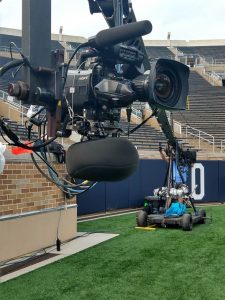NBC Sports Brings Dolby Atmos Back for Notre Dame Home Games
The workflow is evolving for 5.1+4 sound
Story Highlights
A third full season of Dolby Atmos audio is being applied to Notre Dame home football games, and the format is continuing to be a winner for college football. The big news this year is inclusion of tests of the AC4 codec on Notre Dame games on NBC.
The audio component of the new ATSC 3.0 standard will be available to Comcast viewers, who will be able make personalization choices between several announce options.
Fighting Irish Media, Notre Dame’s media arm, has provided extra announce stems, such as home and student radio announce calls of the game, according to Karl Malone, director, sound design, NBC Olympics. Also provided is a live description track for the visually impaired, supplied by Descriptive Video Works, which generates audio description for TV, movies, advertisements, PSAs, and games.

NBC Sports has mounted a pair of DPA 5100 surround mics to help aurally convey the spaciousness of the venue.
“The audio descriptive narrator works from home in Canada,” says Malone, “so we sent a tie-line commentary box, via an AoIP-bonded network, to her in Canada, plus a picture monitor with Apple TV running a ‘Techno Math’ decoder app, allowing millisecond[-delayed] video feeds of the [NEP] ND6 production truck output, which she works to. Her audio is decoded on a tie-line[d] Merlin-plus IP codec in ND6 in Stamford[, CT], and that, plus the Notre Dame radio calls, plus the 5.1.4 game mix, is sent to Comcast, [which is] testing the AC4 codec for the ability to personalize the audio for the listeners at home.
“If [fans] want to hear the student announcers instead of the network announcers,” he continues, “[they] can make that choice on [their] remote. The same goes for audio description for the visually impaired. No longer will the ability to enjoy sports be limited to a mono channel of announcer and effects but instead will be fully immersive in 5.1.4 Dolby Atmos, plus the audio description in the center channel or maybe even the height speakers.”
Remote at Home
The Atmos immersive audio is the complement to the 4K HDR video broadcasts, which began in 2016 for the Fighting Irish’s home games. The ND6 mobile production unit, which was onsite for the four seasons of the Notre Dame 4K HDR broadcasts, has been replaced at Notre Dame Stadium by NEP NCPXI. Helmed by A1 Chris Ross, NCPXI sends the 30 feeds, each embedded with 16 channels of audio, to NBC Sports’ Stamford facility, where A1 Doug Deems mixes the show remotely aboard ND6 as part of the network’s COVID-19 restrictions.
Fans in the Stands With the Bands
As is the case with some other sports, few fans are allowed in the venue. The college is limiting attendance to 15,000 per game — 20% percent of stadium capacity — which provides a useful foundational sound bed for the broadcasts. However, Malone emphasizes, the live band in the stands and other music elements also help fill that space.
“We’ve moved the band from the front left and right speakers more into the height array, which gives us more consistency with the lack of crowds,” he explains. “We’re still channel-based — we’re not experimenting with objects yet — but, with no large crowds, we need to think more about the other elements we do have. We’re placing them in such a way that they sound good in the downmix, too.”
COVID has changed a few other aspects of workflow. For instance, to maintain social distancing, the marching band is spread out over three times the number of seats it would normally occupy. As a result, Deems has had to use an all-shotgun microphone array — a combination of Audio-Technica AT4029 and Sennheiser 416 mics — to capture the band.
Use of prerecorded crowd sounds in the PA system was considered but ultimately rejected, Malone says. Instead, the lower volume levels coming from the stands allows more of the field audio to be picked for the broadcast, which is especially useful since college football doesn’t allow players to be wired for sound.
“We recommended against [using recorded crowd sounds],” he explains. “It colors the audio. Plus, we’re getting a richer effects mix. We’re now able to pick up on the claps and the cadences from the field. We’re also getting audio for that from the SkyCam mic.”
Other new sound sources this year include a pair of DPA 5100 surround microphones: one placed on a jib and the other in the field-entrance tunnel, locations that help aurally convey the spaciousness of the venue. Deems notes that the surround mic in the tunnel has been particularly spectacular, replacing an arrangement of four lavalier microphones he placed there last year to catch the marching band and other event elements as they entered the left end zone.
“It sounds awesome for the band,” he says, “and, because the surround mic puts all of the [transducer] elements in the same place, it really helps phase consistency in the downmix.” He adds that, as many as 120 channels of audio are being collected from the venue.
The downmix, from Atmos to 5.1 surround, is also different this year, an evolution that is being done in the ND6’s Calrec console itself, instead of in the Dolby processor, and is sent through the console. That, says Deems, fully eliminates latency issues that could cause problems for a live event and also provides more flexibility in his mix, assuring that, for instance, elements that he would place in the overhead speakers for the 4K HDR stream would still be present in the 5.1 downmix for the SDR video. In the past, those elements might have been clipped from the SDR version.
“It’s complex, but football sounds incredible in Atmos,” says Deems. “Even with only a fraction of the fans there, we’re still able to convey all the excitement of a Notre Dame home game.”
